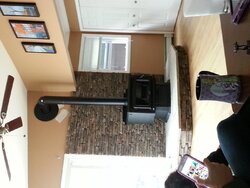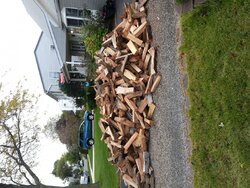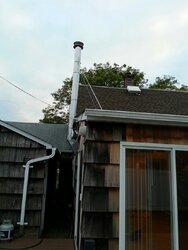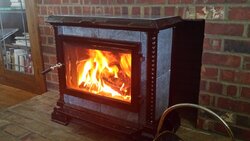Hey guys I'm a complete newbie with wood burning, I just purchased an osburn 2400 stove and had a bunch of seasoned wood delivered. I'm packing the stove with 3-4 large pieces of wood and even with the damper all the way closed, im only getting around 1 hour of the wood burning before there is hardly any wood left and I have to reload. What am I doing wrong? How do you get thee 6-8 hour burn times I read about ? I feel like I shouldn't have to be reloading the stove so fast. Is something wrong with my stove? Thanks for the help.
Need Help..burning through wood fast
- Thread starter R0ck632
- Start date
-
Active since 1995, Hearth.com is THE place on the internet for free information and advice about wood stoves, pellet stoves and other energy saving equipment.
We strive to provide opinions, articles, discussions and history related to Hearth Products and in a more general sense, energy issues.
We promote the EFFICIENT, RESPONSIBLE, CLEAN and SAFE use of all fuels, whether renewable or fossil.
You are using an out of date browser. It may not display this or other websites correctly.
You should upgrade or use an alternative browser.
You should upgrade or use an alternative browser.
- Status
- Not open for further replies.
KindredSpiritzz
Minister of Fire
aansorge
Minister of Fire
My guess is that you don't know what constitutes a burn in an EPA stove. Generally you only get about 1 to 2 hours of burn and then 2 to 3 hours of 'coaling'. During the burning stage you do generate the most heat but during the coaling stage you are still getting good heat. Allow the stove to go through the entire cycle (probably about 5 hours on that stove) before reloading or else you will constantly be shoveling out coals to make room. Can you load up a load before bed and have enough coals to restart in the morning?
weatherguy
Minister of Fire
The 2400 has a good size box, you should get a longer burn time than 5 hours. My guess is you're not running it correctly, I've only burned a cat stove so I'm not much help on running your stove but someone else should be along to run you through the process. Sure your wood is good and seasoned?
I do know that both cat and non cat you want to get them hot then slowly turn the air down until it almost all the way off, then the off gassing will be burned by the secondary air and that's how you get secondaries, with my cat stove the cat burned the gasses.
Tell us your routine.
I do know that both cat and non cat you want to get them hot then slowly turn the air down until it almost all the way off, then the off gassing will be burned by the secondary air and that's how you get secondaries, with my cat stove the cat burned the gasses.
Tell us your routine.
How quickly are you closing the air control on the stove? How are you loading the wood in the stove?
dafattkidd
Minister of Fire
Hey Rock,Hey guys I'm a complete newbie with wood burning, I just purchased an osburn 2400 stove and had a bunch of seasoned wood delivered. I'm packing the stove with 3-4 large pieces of wood and even with the damper all the way closed, im only getting around 1 hour of the wood burning before there is hardly any wood left and I have to reload. What am I doing wrong? How do you get thee 6-8 hour burn times I read about ? I feel like I shouldn't have to be reloading the stove so fast. Is something wrong with my stove? Thanks for the help.
I have the insert version of your stove. I'm sure we can help you get some answers. We just need some more info. How tall is your chimney? How many inches in diameter are the 3-4 pieces of wood? Any hunch as to the species of the wood? Are you measuring the stove top temps throughout the burn? Some pics of the wood, the stove loaded with the 3-4 pieces and your set up will help.
prezes13
Minister of Fire
It all depends on your wood too. What kind of wood what size are the splits. For example right now I am burning small splits of sycamore. I load my stove full with it and I get 5-6 hours. Yesterday morning about 6am I put in 8 Ecko Bricks in the stove before I left for work. I got home about 5:30 pm and fan was still on and enough of orange glow to restart if I wanted too.
TheRambler
Feeling the Heat
I am assuming that after that 1 hourish time span you have a large bed of coals? If not then there is a definite issue with something.
As already stated jn most epa stoves tour going to get 1-3 hours of flames, then it will enter the coaljng stage, where you will continue to have some secondaries for a while before it starts tapering off. What are the stovetop and flue temps after that 1 hour? At 2,3,4+ hr marks and then at the 6+ mark?
As already stated jn most epa stoves tour going to get 1-3 hours of flames, then it will enter the coaljng stage, where you will continue to have some secondaries for a while before it starts tapering off. What are the stovetop and flue temps after that 1 hour? At 2,3,4+ hr marks and then at the 6+ mark?
Thanks for the help guys. Again pardon my lack of knowledge. The Chimney Height inside the house is about 6 Foot, and outside another 6-7 Feet. Iam not sure what kind of wood was delivered suppose to be all hardwoods and the guy i ordered from said its been sitting for about a year. I attached a pic of the chimney and wood delivery. The Pieces are large about 16-18 inches long some larger and about 3 diameter again some smaller and larger. I have a magnetic thermometer on the top of the stove and when filled with 3-4 large pieces temps get up to 550-600 degrees. I then turn the damper all the way off to the left and am getting great secondary burns but the wood just seems to be burning down so quickly. Maybe thats how its suppose to be and it just seems like that to me. Thanks again for the help.
Attachments
The splits are pretty skinny. That will help them dry quicker, but they'll also burn quicker. Our splits are about 3 times as thick.
Try packing the stove will all splits parallel and with minimum air gaps between them. Turn down the air sooner. Go by the flame, not necessarily by the temperature. With good dry wood I was turning down the stove at 225F stove top this morning on an almost cold start.
Try packing the stove will all splits parallel and with minimum air gaps between them. Turn down the air sooner. Go by the flame, not necessarily by the temperature. With good dry wood I was turning down the stove at 225F stove top this morning on an almost cold start.
Sorry, I don't know the pics uploaded sideways.
iPhone? Hold the camera horizontal.
It's a process. You have to play around a bit. I finally loaded my stove almost to the top (1-2" from the burn tubes) last night with oak, got it really hot on top (wood's not quite perfectly seasoned, but pretty good, judging by how it burns), and after burning it at or above 600 for almost 20 minutes, I was able to slowly turn it down to, I don't know, 1/8, maybe 3/16 of the way open (talking primary air here), and go to bed. 7 hours after turning it down, I got up, and the blower was on, stovetop at 200+, lots of good coals left. This is my first successful overnight burn (I did have a little spot of dirty glass, so it wasn't perfect). But, since I'm new to burning with my stove, I'm always tinkering with the air, going outside and seeing if any visible emissions are coming form the chimney, etc. I frequently close it down too soon, kill the flame, then open it back up and let the fire re-establish, try again... I'm just starting to get a feel for it, three weeks into the season. I'm finding my stove burns best when it's full (I think this is common).
You might have a problem, or you just might need to become obsessed with getting it right and be willing to play with it (the fire, I'm talking about the fire).
You might have a problem, or you just might need to become obsessed with getting it right and be willing to play with it (the fire, I'm talking about the fire).
Sprinter
Minister of Fire
You get the longer burn times by packing the stove to the hilt with good quality (high BTU content) wood that is dry to about 20% moisture content and burning it slowly while making sure the secondaries are burning.
"Burn time" means different things to different folks. Seems like the most common definition is when there are enough coals left to start the next fire, but not necessarily pumping out a certain amount of heat. It can vary, though, depending on who you're talking to.
You should verify the actual moisture content of that wood, because there is also no real definition of "seasoned". Sitting for a year may or may not do it depending on the species and whether it was split and stacked for all that time. The only way to know the state of your wood is to get a moisture meter and open one of the splits and measure a fresh face. This needs to be done regardless of all the other variables being offered here.
Welcome to the forum. You'll get it figured out here.
"Burn time" means different things to different folks. Seems like the most common definition is when there are enough coals left to start the next fire, but not necessarily pumping out a certain amount of heat. It can vary, though, depending on who you're talking to.
You should verify the actual moisture content of that wood, because there is also no real definition of "seasoned". Sitting for a year may or may not do it depending on the species and whether it was split and stacked for all that time. The only way to know the state of your wood is to get a moisture meter and open one of the splits and measure a fresh face. This needs to be done regardless of all the other variables being offered here.
Welcome to the forum. You'll get it figured out here.
brad wilton
Feeling the Heat
I think your splits might be to small.try a couple of big pieces and see how long a burn you get you might have gotten softwood instead have somebody check your wood for you.also thanx for all your tips on the forum guys every bit helps
Jonathan Corcoran
New Member
I am new too and recently moved into my grandparent's house the Homestead was installed a few days ago and we just had our first night with a real fire. It was ripping away at 10:30pm and the house was 70 with the temp outside at 20. At 6:30am the stove was out and around 90 degrees.
I was searching this morning for some info or things to try to get the burn time up. I am thinking I will try some larger splits based on the above info. We had to split pretty small due to getting a late start on the wood pile
I was searching this morning for some info or things to try to get the burn time up. I am thinking I will try some larger splits based on the above info. We had to split pretty small due to getting a late start on the wood pile

Attachments
MarylandGuy
Member
I am new too and recently moved into my grandparent's house the Homestead was installed a few days ago and we just had our first night with a real fire. It was ripping away at 10:30pm and the house was 70 with the temp outside at 20. At 6:30am the stove was out and around 90 degrees.
I was searching this morning for some info or things to try to get the burn time up. I am thinking I will try some larger splits based on the above info. We had to split pretty small due to getting a late start on the wood pile
The Homestead prefers smaller splits to optimize the secondary burn. Sure you can use larger splits, but the secondary burn time is reduced, which means the larger wood will probably smoulder more overnight. Which of course gives you more coals in the morning and more buildup in your chimney.
These stoves have a small firebox. There isn't much you can do to extend the overnight burn. On really cold nights, I will load it up around 11pm, and maybe reload it around 4 or 5am and go back to bed.
Jonathan Corcoran
New Member
The Homestead prefers smaller splits to optimize the secondary burn. Sure you can use larger splits, but the secondary burn time is reduced, which means the larger wood will probably smoulder more overnight. Which of course gives you more coals in the morning and more buildup in your chimney.
These stoves have a small firebox. There isn't much you can do to extend the overnight burn. On really cold nights, I will load it up around 11pm, and maybe reload it around 4 or 5am and go back to bed.
Thanks! Most of our Doug Fir is in the 3-6 in diameter range, so it sounds like we are in the right place. I've been wanting to get up earlier so it sounds like I've found my reason. So far we are feedin the stove 2 or 3 splits every couple of hours. I really appreciate the feedback. I told my wife this was the place for help!
JayD
Feeling the Heat
The wood in picture 2 looks pretty freshly split? Those gray pcs you see in the photo look like they maybe 1 year split and your driest, Try a load of those gray splits. My wood is well seasoned and they turn grey silver color. Also remember 50% of your heat is flame 50% comes from good hot coals, Your not going to get 6-8 hours of flame. jay
ryanm527
Member
I agree that the wood looks pretty fresh. I buy about half my supply and cut the rest. The fellow that brings it, like just about every other firewood seller, always describes it as "seasoned". You will find that buyers and sellers often have a different definition of the term. It took me awhile to realize just how long it takes for wood to truly "season", especially wood like oak. But it makes a huge difference in heat output. Getting truly seasoned wood is usually a challenge the first year or two when getting into wood burning.
Like others have suggested, I start with the air open, then slowly adjust it down. We get good flames for a couple hours, and heat for a couple hours beyond that. Most of the time it will keep a good coal bed overnight for easy restocking in the morning.
Like others have suggested, I start with the air open, then slowly adjust it down. We get good flames for a couple hours, and heat for a couple hours beyond that. Most of the time it will keep a good coal bed overnight for easy restocking in the morning.
JayD
Feeling the Heat
ROck. Pick up a few packs of ECO blocks from tractor supply supply co and add 1-2 per load of wood and how things go, If you get the big flat one's 3 to a pack use 1 per load, Smaller ones I linked 2 per load I think that may help out. http://www.tractorsupply.com/en/store/redstonetrade;-ecobrick-pack-of-6 Follow this thread https://www.hearth.com/talk/threads/eco-bricks-do-you-use-them.134891/#post-1812915
- Status
- Not open for further replies.
Similar threads
- Replies
- 23
- Views
- 1K
- Replies
- 14
- Views
- 1K
- Replies
- 4
- Views
- 549
- Replies
- 11
- Views
- 1K






